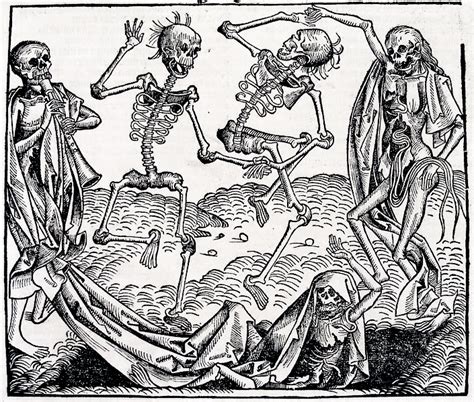Black Death: When Did the Pandemic Strike Europe?

The Black Death, one of the most devastating pandemics in human history, left an indelible mark on Europe during the 14th century. Its arrival and relentless spread reshaped societies, economies, and cultures in ways that are still studied and debated today. But when exactly did this cataclysmic event strike Europe? To answer this, we must delve into the historical timeline, the origins of the plague, and its rapid dissemination across the continent.
The Origins and Early Spread of the Black Death
The Black Death, caused by the bacterium Yersinia pestis, is believed to have originated in the steppe regions of Central Asia. From there, it traveled along the Silk Road, the vast network of trade routes connecting Asia, the Middle East, and Europe. The pandemic first emerged in the 1330s in China and Mongolia, where it decimated populations before moving westward.
By the early 1340s, the plague had reached the Crimean Peninsula, a key trading hub. In 1347, it arrived in Messina, Sicily, aboard Genoese trading ships carrying infected rats and fleas. These ships, which had docked in the Crimea, unwittingly became vessels of death, carrying the plague to the heart of Europe.
The Arrival in Europe: 1347–1348
The Black Death entered Europe in October 1347, when the infected ships docked in Messina. The sight of sailors with blackened, swollen lymph nodes—a hallmark of bubonic plague—terrified the locals. Despite quarantine efforts, the disease spread rapidly along trade routes, maritime networks, and pilgrim paths.
By 1348, the plague had reached Marseille, Pisa, and Genoa, major port cities that served as gateways to the European interior. From there, it moved inland, striking cities like Florence, Paris, and London with unrelenting force. The speed of its spread was unprecedented, fueled by the lack of medical knowledge, poor sanitation, and the constant movement of people and goods.
The Peak of the Pandemic: 1348–1351
The Black Death reached its zenith in Europe between 1348 and 1351, during which it ravaged nearly every corner of the continent. By 1350, it had spread as far north as Norway and as far east as Russia. The death toll was staggering, with estimates suggesting that 30% to 60% of Europe’s population perished. In some cities, like Florence, the mortality rate exceeded 50%.
The pandemic’s impact was not limited to human lives. It disrupted agricultural production, trade, and labor systems, leading to economic collapse in many regions. The social fabric of Europe was torn apart, with religious fervor, persecution (often targeting Jews), and despair becoming widespread.
The Aftermath and Recurring Outbreaks
While the initial wave of the Black Death subsided by 1351, the plague did not disappear entirely. It returned periodically in the form of secondary outbreaks, such as the Great Plague of London in 1665–1666 and the Marseilles Plague of 1720–1722. These recurring epidemics kept the specter of the Black Death alive in the European consciousness for centuries.
Key Takeaway: The Black Death struck Europe in 1347, arriving in Messina, Sicily, and rapidly spreading across the continent by 1351. Its peak years were 1348–1350, during which it claimed millions of lives and reshaped European society.
The Historical Significance of the Black Death
The Black Death’s arrival in Europe marked a turning point in history. It accelerated the decline of feudalism, as labor shortages led to higher wages and greater social mobility for peasants. It also spurred advancements in medicine, public health, and urban planning, as societies sought to prevent future pandemics.
Expert Insight: Historian Philip Daileader notes, "The Black Death was not just a biological event; it was a catalyst for profound social, economic, and cultural change in Europe."
Comparative Analysis: The Black Death vs. Other Pandemics
To understand the Black Death’s magnitude, it’s useful to compare it to other historical pandemics. The 1918 Influenza Pandemic, for instance, killed an estimated 50 million people worldwide, but its impact was less transformative than the Black Death due to the societal differences between the 14th and 20th centuries.
| Pandemic | Time Period | Estimated Deaths | Impact |
|---|---|---|---|
| Black Death | 1347–1351 | 75–200 million | Transformed European society, economy, and culture |
| 1918 Influenza | 1918–1920 | 50 million | Significant but less transformative due to modern societal structures |

Myth vs. Reality: Common Misconceptions About the Black Death
Myth: The Black Death was caused by poor hygiene alone.
Reality: While poor sanitation contributed to its spread, the primary vector was fleas on rats, which were ubiquitous in medieval Europe.
Myth: The Black Death wiped out 90% of Europe’s population.
Reality: Estimates range from 30% to 60%, not 90%, though local mortality rates varied widely.
Future Implications: Lessons from the Black Death
The Black Death serves as a stark reminder of humanity’s vulnerability to pandemics. In the 21st century, diseases like COVID-19 have highlighted the importance of global cooperation, scientific research, and public health measures. By studying the Black Death, we can better prepare for and mitigate the impact of future outbreaks.
Steps to Prevent Future Pandemics:
- Strengthen global health surveillance systems.
- Invest in vaccine development and distribution.
- Improve sanitation and hygiene in vulnerable regions.
- Educate communities about disease prevention.
FAQ Section
What caused the Black Death?
+The Black Death was caused by the bacterium Yersinia pestis, primarily transmitted through fleas on infected rats.
How many people died in the Black Death?
+Estimates suggest that 75–200 million people died worldwide, with Europe losing 30% to 60% of its population.
Did the Black Death lead to any positive changes?
+Yes, it accelerated the decline of feudalism, increased wages for peasants, and spurred advancements in medicine and public health.
Why is it called the Black Death?
+The name derives from the blackening of skin due to subcutaneous hemorrhages, a symptom of bubonic and pneumonic plague.
Could a pandemic like the Black Death happen again?
+While modern medicine reduces the risk, the emergence of new diseases and antibiotic resistance means pandemics remain a threat.
Conclusion: A Legacy of Resilience and Reflection
The Black Death’s arrival in Europe in 1347 marked the beginning of a catastrophic era that reshaped the continent’s trajectory. Its legacy is one of both devastation and resilience, reminding us of humanity’s capacity to endure and adapt in the face of unimaginable challenges. As we confront modern pandemics, the lessons of the Black Death remain as relevant as ever, urging us to learn from history and prepare for the future.



